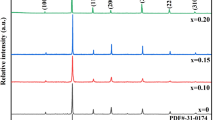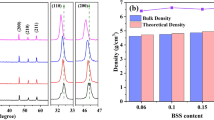Abstract
Bismuth layer structured ferroelectric Bi3R2Ti3FeO15 with R = Bi (BFTO), Gd (BGFTO), and Nd (BNFTO) composition were synthesized by solid-state route, and their morphology and dielectric properties were investigated. The BGFTO and BNFTO samples, show a decrease in dielectric characteristics compared to BFTO. This can be explained by structural distortion resulting from the replacement of lanthanides in the cations of A-site in the perovskite layer. Impedance spectroscopy was performed to establish a correlation between the electrical properties and the microstructure of the ceramics. A non-Debye relaxation induced by a thermally activated mechanism can be observed in all samples. The activation energy of the materials found in the range of 0.6–0.9 eV and indicates the association of doubly ionized oxygen vacancy. The three phases proved to be news candidates for X4D capacitors, with excellent temperature stability (29–150 °C, TCC ≤ ± 3.3%). In addition, the electroceramics were used to design a cylindrical dielectric resonator antenna (CDRA) for microwave applications. The Bi3R2Ti3FeO15-based CDRA showed great potential for microwave antenna application operating in the S-band. A change is observed to τf of BFTO phase (− 428.48 ppm °C−1) to BGFTO (+ 59.17 ppm °C−1) and BNFTO (+ 57.69 ppm °C−1). This result opens up a great opportunity for future work in CDRA with near-zero temperature coefficients (τf ∼ 0).








Similar content being viewed by others
Change history
02 July 2021
A Correction to this paper has been published: https://doi.org/10.1007/s10854-021-06411-6
References
S.K. Badge, A.V. Deshpande, Study of dielectric and ferroelectric properties of Bismuth Titanate (Bi4Ti3O12) ceramic prepared by sol–gel synthesis and solid-state reaction method with varying sintering temperature. Solid State Ion. 334, 21–28 (2019). https://doi.org/10.1016/j.ssi.2019.01.028
Y. Shi, Y. Pu, J. Li, R. Shi, W. Wang, Q. Zhang, L. Guo, Structure, dielectric and multiferroic properties of three-layered Aurivillius SrBi3Nb2FeO12 ceramics. Ceram. Int. 45(7), 9283–9287 (2019). https://doi.org/10.1016/j.ceramint.2019.01.129
P. Gupta, P.K. Mahapatra, R.N.P. Choudhary, Structural and electrical characteristics of Bi2YZrVO9 ceramic. Mater. Res. Bull. 124, 110745 (2020). https://doi.org/10.1016/j.materresbull.2019.110745
S. Sun, Y. Li, X. Yin, C. Liu, X. Li, R. Ti, L. Fang, T. Zhang, R. Peng, Y. Lu, The nanoscale control of disorder-to-order layer-stacking boosts multiferroic responses in an Aurivillius-type layered oxide. J. Mater. Chem. C 9(14), 4825–4837 (2021). https://doi.org/10.1039/D1TC00309G
S. Sun, W. Wang, J. Chen, Z. Xiao, N. Cheng, Z. Zhao, Y. Tian, X. Yin, Substrate- and layer-effects on structural and photovoltaic properties of spin-coated Aurivillius-type Bim+1Fem-3Ti3O3m+3 thin films. J. Alloys Compd. 851, 156833 (2021). https://doi.org/10.1016/j.jallcom.2020.156833
S. Sun, X. Yin, Engineered layer-stacked interfaces inside Aurivillius-type layered oxides enables superior ferroelectric property. Curr. Comput. Aided Drug Des. 10(8), 710 (2020). https://doi.org/10.3390/cryst10080710
V. Koval, I. Skorvanek, G. Viola, M. Zhang, C. Jia, H. Yan, Crystal chemistry and magnetic properties of Gd-substituted Aurivillius-type Bi5FeTi3O15 ceramics. J. Phys. Chem. C 122(27), 15733–15743 (2018). https://doi.org/10.1021/acs.jpcc.8b03801
W.C. Ferreira, G.L.C. Rodrigues, B.S. Araujo, F.A.A. de Aguiar, A.N.A. de Abreu Silva, P.B.A. Fechine, C.W.A. Paschoal, A.P. Ayala, Pressure-induced structural phase transitions in the multiferroic four-layer Aurivillius ceramic Bi5FeTi3O15. Ceram. Int. 46(11), 18056–18062 (2020). https://doi.org/10.1016/j.ceramint.2020.04.122
P.H.T. Silva, M.A.S. Silva, R.B. da Silva, M.A. Correa, F. Bohn, A.S. de Menezes, W.C. Ferreira, A.P. Ayala, A.S.B. Sombra, P.B.A. Fechine, Effects of the Bi3+ substitution on the structural, vibrational, and magnetic properties of bismuth layer-structured ferroelectrics. Appl. Phys. A 126(8), 1–12 (2020). https://doi.org/10.1007/s00339-020-03858-y
Y. Bai, J. Chen, R. Tian, S. Zhao, Enhanced multiferroic and magnetoelectric properties of Ho, Mn co-doped Bi5Ti3FeO15 films. Mater. Lett. 164, 618–622 (2016). https://doi.org/10.1016/j.matlet.2015.11.083
X. Liu, L. Xu, Y. Huang, C. Qin, L. Qin, H.J. Seo, Improved photochemical properties of Aurivillius Bi5Ti3FeO15 with partial substitution of Ti4+ with Fe3+. Ceram. Int. 43(15), 12372–12380 (2017). https://doi.org/10.1016/j.ceramint.2017.06.103
J. Wu, H. Zhang, N. Meng, V. Koval, A. Mahajan, Z. Gao, D. Zhang, H. Yan, Perovskite Bi0.5Na0.5TiO3-based materials for dielectric capacitors with ultrahigh thermal stability. Mater. Des. 198, 109344 (2021). https://doi.org/10.1016/j.matdes.2020.109344
K. Miao, X. Wang, D. Hu, Y. Wang, J. Xiao, Fabrication of Y and Fe co-doped BaZr0.13Ti1.46O3 fine-grained ceramics for temperature-stable multilayer ceramic capacitors. Ceram. Int. 43(12), 9099–9104 (2017). https://doi.org/10.1016/j.ceramint.2017.04.056
D. Han, C. Wang, D. Lu, F. Hussain, D. Wang, F. Meng, A temperature stable (Ba1–xCex)(Ti1–x/2Mgx/2)O3 lead-free ceramic for X4D capacitors. J. Alloys Compd. 821, 153480 (2020). https://doi.org/10.1016/j.jallcom.2019.153480
F.A.A. Aguiar, A.J.M. Sales, B.S. Araújo, K.D.A. Sabóia, M.C. Campos Filho, A.S.B. Sombra, A.P. Ayala, P.B.A. Fechine, Effect of V2O5 addition on the phase composition of Bi5FeTi3O15 ceramic and RF/microwave dielectric properties. J. Electron. Mater. 46, 2467–2475 (2017). https://doi.org/10.1007/s11664-017-5312-4
P.M.O. Silva, T.S.M. Fernandes, R.M.G. Oliveira, M.A.S. Silva, A.S.B. Sombra, Radiofrequency and microwave properties study of the electroceramic BaBi4Ti4O15. Mater. Sci. Eng. B 182, 37–44 (2014). https://doi.org/10.1016/j.mseb.2013.11.017
R.G.M. Oliveira, R.A. Silva, J.E.V. de Morais, G.S. Batista, M.A.S. Silva, J.C. Goes, H.D. de Andrade, I.S. Queiroz Júnior, C. Singh, A.S.B. Sombra, Effects of CaTiO3 addition on the microwave dielectric properties and antenna properties of BiVO4 ceramics. Compos. B 175, 107122 (2019). https://doi.org/10.1016/j.compositesb.2019.107122
C.A. Rodrigues Junior, M.C. Campos Filho, D.G. Sousa, A.J.M. Sales, R.P.S. Leão, A.S.B. Sombra, G.C. Barroso, Structural and electrical properties of the SrBi4Ti4O15: V2O5 matrix in the microwave frequency range. J. Electromagn. Waves Appl. 32(11), 1329–1341 (2018). https://doi.org/10.1080/09205071.2018.1436004
S. Parida, A. Satapathy, E. Sinha, A. Bisen, S.K. Rout, Effect of neodymium on optical bandgap and microwave dielectric properties of barium zirconate ceramic. Metall. Mater. Trans. A 46(3), 1277–1286 (2015). https://doi.org/10.1007/s11661-014-2725-z
C.A. Schneider, W.S. Rasband, K.W. Eliceiri, NIH Image to ImageJ: 25 years of image analysis. Nat. Methods 9, 671–675 (2012). https://doi.org/10.1038/nmeth.2089
B.W. Hakki, P.D. Coleman, A dielectric resonator method of measuring inductive capacities in the millimeter range. IEEE Trans. Microw. Theory Tech. 8, 402–410 (1960). https://doi.org/10.1109/TMTT.1960.1124749
M.A.S. Silva, T.S.M. Fernandes, A.S.B. Sombra, An alternative method for the measurement of the microwave temperature coefficient of resonant frequency (τf). J. Appl. Phys. 112, 74106 (2012). https://doi.org/10.1063/1.4755799
J.A. Horn, S.C. Zhang, U. Selvaraj, G.L. Messing, S. Trolier-McKinstry, Templated grain growth of textured bismuth titanate. J. Am. Ceram. Soc. 82(4), 921–926 (1999). https://doi.org/10.1111/j.1151-2916.1999.tb01854.x
S. Behara, L. Ghatti, S. Kanthamani, M. Dumpala, T. Thomas, Structural, optical, and Raman studies of Gd doped sodium bismuth titanate. Ceram. Int. 44, 12118–12124 (2018). https://doi.org/10.1016/j.ceramint.2018.03.233
J.D. Bobić, R.M. Katiliute, M. Ivanov, M.M. Vijatović Petrović, N.I. Ilić, A.S. Džunuzović, J. Banys, B.D. Stojanović, Dielectric, ferroelectric and magnetic properties of La doped Bi5Ti3FeO15 ceramics. J. Mater. Sci. Mater. Electron. 27, 2448–2454 (2016). https://doi.org/10.1007/s10854-015-4044-6
P. Gupta, P.K. Mahapatra, R.N.P. Choudhary, Structural and electrical characteristics of rare-earth modified bismuth layer structured compounds. J. Alloys Compd. 863, 158457 (2021). https://doi.org/10.1016/j.jallcom.2020.158457
J.R. Macdonald, W.B. Johnson, Fundamentals of impedance spectroscopy, in Impedance Spectroscopy, 3rd edn., ed. by E. Barsoukov, J.R. Macdonald (Wiley, Wiley-interscience, New Jersey, 2018), p. 6. https://doi.org/10.1002/9781119381860.ch1
G.B. Yu, L.G. Wang, C.M. Zhu, F.Z. Lv, F.C. Liu, W.J. Kong, Y.T. Zhao, P.Y. Zeng, Z.H. Huang, Relaxor dielectric properties of lead-free Bi4Ti3O12/Bi4.5Na0.5Ti4O15 intergrowth ceramics. Ceram. Int. 46(7), 9474–9484 (2020). https://doi.org/10.1016/j.ceramint.2019.12.208
D.V.M. Paiva, M.A.S. Silva, T.S. Ribeiro, I.F. Vasconcelos, A.S.B. Sombra, J.C. Goes, P.B.A. Fechine, Novel magnetic-dielectric composite ceramic obtained from Y3Fe5O12 and CaTiO3. J. Alloys Compd. 644, 763–769 (2015). https://doi.org/10.1016/j.jallcom.2015.05.053
M. Zhang, Z. Chen, Y. Yue, T. Chen, Z. Yan, Q. Jiang, B. Yang, M. Eriksson, J. Tang, D. Zhang, Z. Shen, I. Abrahams, H. Yan, Terahertz reading of ferroelectric domain wall dielectric switching. ACS Appl. Mater. Interfaces 13(10), 12622–12628 (2021). https://doi.org/10.1021/acsami.1c00523
S. Mantri, J. Daniels, Domain walls in ferroelectrics. J. Am. Ceram. Soc. 104(4), 1619–1632 (2021). https://doi.org/10.1111/jace.17555
D. Prajapat, A. Sagdeo, V. Raghavendra Reddy, Structural, magnetic and dielectric properties of vanadium substituted four layered Aurivillius Bi5FeTi3O15 ceramics. Ceram. Int. 45(15), 19093–19097 (2019). https://doi.org/10.1016/j.ceramint.2019.06.154
A.K. Jonscher, Dielectric relaxation in solids. J. Phys. D 32, R57–R70 (1999). https://doi.org/10.1088/0022-3727/32/14/201
O. Raymond, R. Font, N. Suárez-Almodovar, J. Portelles, J.M. Siqueiros, Frequency-temperature response of ferroelectromagnetic Pb(Fe1/2Nb1/2)O3 ceramics obtained by different precursors. Part I. Structural and thermo-electrical characterization. J. Appl. Phys. 97, 1–8 (2005). https://doi.org/10.1063/1.1870099
A. Mohapatra, P.R. Das, R.N.P. Choudhary, Structural and electrical properties of Bi5Ti3FeO15 ceramics. J. Mater. Sci. Mater. Electron. 25, 1348–1353 (2014). https://doi.org/10.1007/s10854-014-1733-5
M. Badole, S. Dwivedi, T. Pareek, S.A. Ahmed, S. Kumar, Significantly improved dielectric and piezoelectric properties of BiAlO3 modified potassium bismuth titanate lead-free ceramics. Mater. Sci. Eng. B 262, 114749 (2020). https://doi.org/10.1016/j.mseb.2020.114749
C. Ji, T. Fan, G. Chen, X. Bai, J. Wang, J. He, W. Cai, R. Gao, X. Deng, Z. Wang, X. Lei, C. Fu, Influence of sintering method on microstructure, electrical and magnetic properties of BiFeO3–BaTiO3 solid solution ceramics. Mater. Today Chem. 20, 100419 (2021). https://doi.org/10.1016/j.mtchem.2020.100419
S. Sharma, K. Shamim, A. Ranjan, R. Rai, P. Kumari, S. Sinha, Impedance and modulus spectroscopy characterization of lead-free barium titanate ferroelectric ceramics. Ceram. Int. 41(6), 7713–7722 (2015). https://doi.org/10.1016/j.ceramint.2015.02.102
A.K. Jonscher, The “universal” dielectric response. Nature 267, 673–679 (1977). https://doi.org/10.1038/267673a0
D.K. Kushvaha, B. Tiwari, S.K. Rout, Enhancement of electrical energy storage ability by controlling grain size of polycrystalline BaNb2O6 for high density capacitor application. J. Alloys Compd. 829, 154573 (2020). https://doi.org/10.1016/j.jallcom.2020.154573
B.C. Sutar, R.N.P. Choudhary, P.R. Das, Dielectric and impedance spectroscopy of Sr(Bi0.5Nb0.5)O3 ceramics. Ceram. Int. 40, 7791–7798 (2014). https://doi.org/10.1016/j.ceramint.2013.12.122
A. Maaroufi, O. Oabi, B. Lucas, Ac-conductivity and dielectric response of new zinc-phosphate glass/metal composites. Phys. B 492, 31–38 (2016). https://doi.org/10.1016/j.physb.2016.03.035
A.S. Bondarenko, G.A. Ragoisha, in Progress in Chemometrics Research, ed. by A.L. Pomerantsev (Nova Science Publishers, New York, 2005), pp. 89–102 (the program is available online at http://www.abc.chemistry.bsu.by/vi/analyser/). Accessed 20 Feb 2021.
S. Thakur, R. Rai, I. Bdikin, S.P. Rai, Dielectric relaxation and ac conduction in multiferroic Bi0.8Gd0.1Pb0.1Fe0.9Ti0.1O3 ceramics: impedance spectroscopy analysis. Phase Transit. 89, 1213–1224 (2016). https://doi.org/10.1080/01411594.2016.1160399
N. Okasha, S.I. El-Dek, M. Ayman, A.I. Ali, Comparative study on the influence of rare earth ions doping in Bi0.6Sr0.4FeO3 nanomultiferroics. J. Alloys Compd. 689, 1051–1058 (2016). https://doi.org/10.1016/j.jallcom.2016.08.077
S. Jangra, S. Sanghi, A. Agarwal, M. Rangi, K. Kaswan, Effects of Nd3+ and high-valence Nb5+ co-doping on the structural, dielectric and magnetic properties of BiFeO3 multiferroics. Ceram. Int. 44, 7683–7693 (2018). https://doi.org/10.1016/j.ceramint.2018.01.194
B. Pandit, B.R. Sankapal, P.M. Koinkar, Novel chemical route for CeO2/MWCNTs composite towards highly bendable solid-state supercapacitor device. Sci. Rep. 9, 5892 (2019). https://doi.org/10.1038/s41598-019-42301-y
M. Pan, C.A. Randall, A brief introduction to ceramic capacitors. IEEE Electr. Insul. Mag. 26, 44–50 (2010). https://doi.org/10.1109/MEI.2010.5482787
H. Ohsato, M. Mizuta, T. Okuda, S. Nishigaki, Crystal structure and microwave dielectric properties of tungsten bronze type Ba6–3xR8+2xTi18O54 (R = La,Pr, Nd, and Sm) solid solutions, in Proc. XVII Conf. App. Crystallogr., (World Scientific Publishers, Singapore, 1998) pp. 440–447.
S.K. Badge, A.V. Deshpande, La3+ modified bismuth titanate (BLT) prepared by sol–gel synthesis: structural, dielectric, impedance, and ferroelectric studies. Solid State Ion. 347, 115270 (2020). https://doi.org/10.1016/j.ssi.2020.115270
K. Fukuda, R.K. Awai, Microwave characteristics of TiO2-Bi2O3 dielectric resonator. Jpn. J. Appl. Phys. 32, 4584 (1993). https://doi.org/10.1143/JJAP.32.4584
M.R. Islam, M.T. Islam, M. Moniruzzaman et al., Penta band single negative meta-atom absorber designed on square enclosed star-shaped modified split ring resonator for S-, C-, X- and Ku-bands microwave applications. Sci Rep 11, 8784 (2021). https://doi.org/10.1038/s41598-021-87958-6
Z. Wang, Y. Chen, Structures and microwave dielectric properties of Ti-doped CeO2 ceramics with a near-zero temperature coefficient of resonant frequency. J. Alloys Compd. 854, 157270 (2021). https://doi.org/10.1016/j.jallcom.2020.157270
Y. Ji, K. Song, S. Zhang, Z. Lu, G. Wang, L. Li, D. Zhou, D. Wang, I.M. Reaney, Cold sintered, temperature-stable CaSnSiO5-K2MoO4 composite microwave ceramics and its prototype microstrip patch antenna. J. Eur. Ceram. Soc. 41, 424–429 (2021). https://doi.org/10.1016/j.jeurceramsoc.2020.08.053
J. Wang, X. Lu, Y. Li, L. Wang, H. Zhu, Z. Fu, F. Yan, X. Wang, Q. Zhang, Correlations between microwave dielectric properties and crystal structures of Sb-doped Co0.5Ti0.5NbO4 ceramics. Ceram. Int. 46(3), 3464–3470 (2020). https://doi.org/10.1016/j.ceramint.2019.10.059
Acknowledgements
We gratefully acknowledge the financial support of the following Brazilian agencies for scientific and technological development: CNPq (408790/2016-4), CAPES (Finance Code 001, PROEX 23038.000509/2020-82) and Funcap (PNE-0112-00048.01.00/16). Moreover, the authors also acknowledge the Central Analítica-UFC/CT-INFRA/MCTI-SISNANO/Pró-Equipamentos for providing equipment and technical support for the experiments involving SEM.
Author information
Authors and Affiliations
Corresponding author
Additional information
Publisher's Note
Springer Nature remains neutral with regard to jurisdictional claims in published maps and institutional affiliations.
Rights and permissions
About this article
Cite this article
Silva, P.H.T., Silva, M.A.S., Sombra, A.S.B. et al. Dielectric properties of bismuth layer structured ferroelectric Bi3R2Ti3FeO15 (R = Bi, Gd, and Nd) at microwave and radiofrequency. J Mater Sci: Mater Electron 32, 18628–18643 (2021). https://doi.org/10.1007/s10854-021-06332-4
Received:
Accepted:
Published:
Issue Date:
DOI: https://doi.org/10.1007/s10854-021-06332-4




